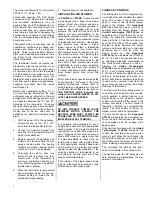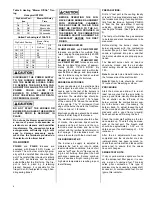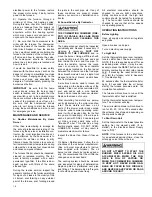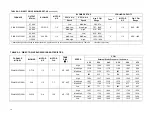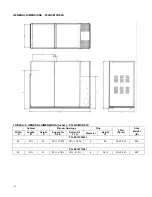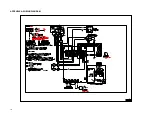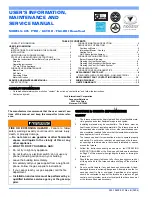
6
not interfere with the combustion air
supplied to the burner. The control
should be located a minimum of 3 flue
pipe diameters from the furnace breech-
ing and installed in accordance to the
instructions supplied with the regulator.
Table 3: Minimum Chimney Base
Temperatures (°F)
Chimney Height (ft.)
Nozzle
11 20 28 36
Chimney Thermal Resistance < R6
0.50 300
400
535
725
0.65 275
340
430
535
0.70 270
330
405
505
0.75 260
320
380
475
0.85 250
300
355
430
1.00 255
300
365
430
Chimney Height (ft.)
Nozzle
11 20 28 36
Chimney Thermal Resistance > R6
0.50 185
200
220
250
0.65 175
185
205
220
0.70 175
185
195
215
0.75 175
185
195
210
0.85 165
185
195
205
1.00 165
185
195
205
< -
Less than
, > -
greater than
OIL TANK
Oil storage tanks must be selected and
installed in compliance with applicable
codes; in the United States,
NFPA 31,
Standard for the Installation of Oil
Burning Equipment,
Chapter 2. and in
Canada,
CAN/CSA-B139, Installation
Code for Oil Burning Equipment
, Sec-
tion 6. Observe all local codes and by-
laws.
In general, the oil tank must be properly
supported and remain stable in both
empty and full condition. The oil tank
must be fitted with vent and supply pipes
to the outdoors. Refer to the above-
mentioned codes for sizing. The vent
pipe must be no less than 1¼ inches
I.P.S., and terminate with an appropriate
vent cap in a location where it will not be
blocked. The fill pipe must be no less
than 2 inches I.P.S., and terminate with
an appropriate cap in a location where
debris will not enter the fill pipe during oil
delivery.
If located indoors, the tank should nor-
mally be in the lowest level, (cellar,
basement, etc.). It must be equipped
with a shut-off valve at the tank outlet
used for the oil supply. The oil tank must
be located as to not block the furnace /
room exit pathway. Observe all clear-
ances specified in the above-mentioned
codes.
PIPING INSTALLATION
In the United States,
NFPA 31, Stan-
dard for the Installation of Oil Burning
Equipment, Chapter 2
.
In Canada, the entire fuel system should
be installed in accordance with the re-
quirements of
CAN/CSA B139
, and local
regulations. Use only approved fuel oil
tanks piping, fittings and oil filters.
Ensure that all fittings used in a copper
oil line system are high quality flare fit-
tings. Do not use compression fittings.
Do not use Teflon tape on any fittings.
Pressurized or gravity feed installations
must not exceed 3 PSIG. Pressures
greater than 10 PSIG may cause dam-
age to the shaft seal. If the height of the
oil stored in a tank above the oil burner
exceeds 11½ feet, it may be necessary
to use a pressure-regulating device ap-
proved for this purpose.
The furnace may be installed with a one-
pipe system with gravity feed or lift. The
maximum allowable lift on a single line
system is 8 feet. Lift should be measured
from the bottom (outlet) of the tank, to
the inlet of the burner. Sizing a single
line system is complex because of the
difficulty estimating the pressure drop
through each fitting, bend and compo-
nent in the line. In general, keep single
line systems short as possible. 2-stage
oil pumps are not available for either the
P3HMX or P3LBX
furnaces. The follow-
ing chart shows the allowable line
lengths (hori vertical) for single
and two-line oil piping systems. All dis-
tances are in feet.
In retrofit applications, where an existing
oil line system is in place, a vacuum
check will help determine the efficacy of
the existing oil line system The vacuum
in a system should not exceed 6” Hg. for
a single pipe system, nor 12” Hg. for a
two-pipe system.
NOTE
: The oil burner requires the use of
a bypass plug when converting from
single-pipe to two-pipe oil piping sys-
tems. See burner manufacturer’s instruc-
tions.
All fuel systems should include an oil
filter between the fuel oil storage tank
and the oil burner. For best results, in-
stall the oil filter as close to the burner as
possible. When using an indoor oil tank,
the oil filter may be installed at the tank
downstream from the shut-off valve. If
firing the furnace under the 0.65 gph
rate, a 7 to 10 micron line filter should be
installed as close to the oil burner as
possible.
Table 4: Oil Lines
Copper Tubing Oil Line Length (Feet)
Single-Pipe Two-Pipe
Lift
(Feet)
3/8”
OD
1/2”
OD
3/8”
OD
1/2”
OD
0 53 100 68 100
1 49 100 65 100
2 45 100 63 100
3 41 100 60 100
4 37 100 58 100
5 33 100 55 100
6 29 100 53 100
7 25 99 50 100
8 21 83 48 100
9 17 68 45 100
10 13 52 42 100
12
- - -
- - -
37
100
14
- - -
- - -
32
100
16
- - -
- - -
27
100
18
- - -
- - -
22
88
ELECTRICAL CONNECTIONS
The furnace is listed by the
Canadian
Standards Association (CSA)
. It is
factory wired and requires minimal field
wiring. In the United States, the wiring
must be in accordance with the
National
Fire Protection Association
NFPA-70
,
National Electrical Code
, and with local
codes and regulations. In Canada, all
field wiring should conform to
CAN/CSA
C22.1 Canadian Electrical Code, Part
1
, and by local codes, where they pre-
vail.
The furnace should be wired to a sepa-
rate and dedicated circuit in the main
electrical panel; however, accessory
equipment such as electronic air clean-
ers and humidifiers may be included on
the furnace circuit. Although a suitably
located circuit breaker can be used as a
service switch, a separate service switch
is advisable. The service switch is nec-
essary if reaching the circuit breaker
involves becoming close to the furnace,
or if the furnace is located between the
circuit breaker and the means of entry to
the furnace room. The furnace switch
(service switch) should be clearly
marked, installed in an easily accessible
area between the furnace and furnace
room entry, and be located in such a
manner to reduce the likelihood that it
would be mistaken as a light switch or
similar device.
Содержание P3HMX12F08001
Страница 16: ...16 APPENDIX A WIRING DIAGRAM ...







